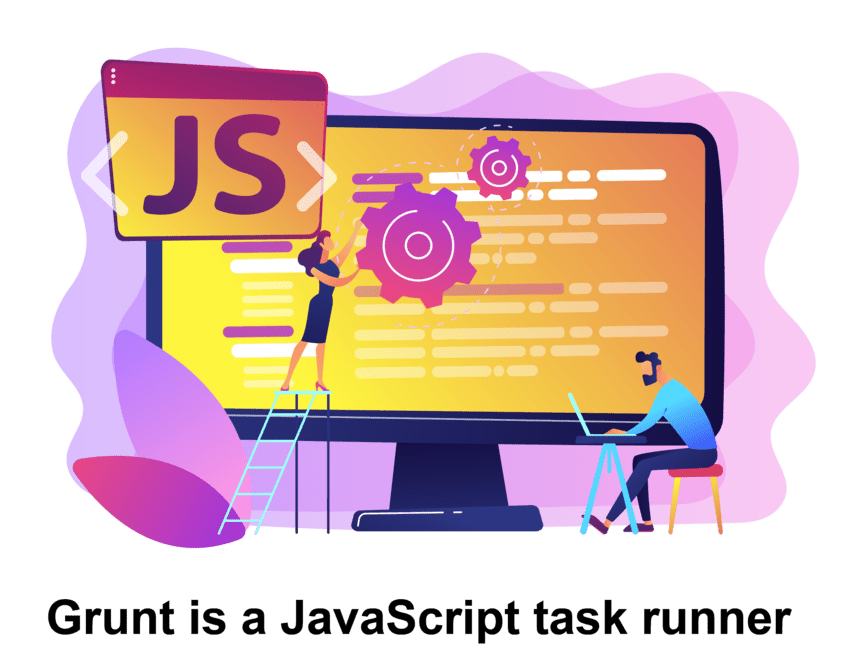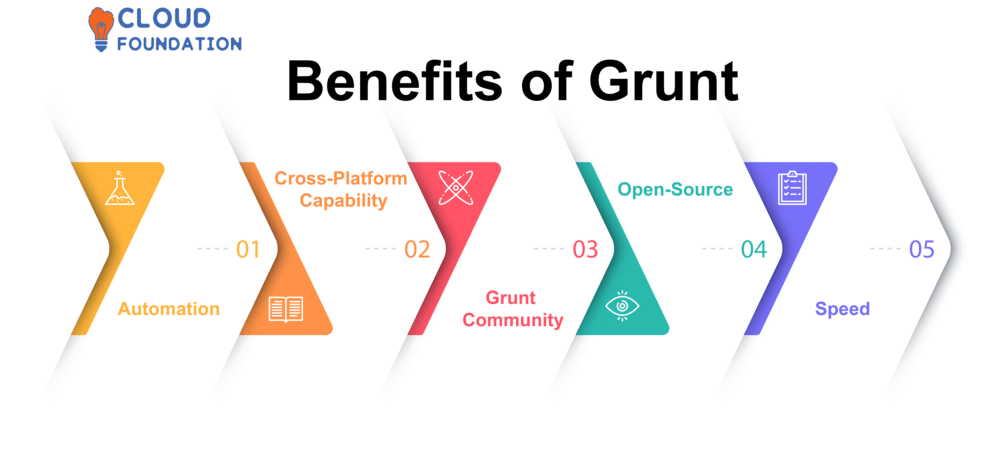What is Grunt & uses of Grunt Software?
Hello readers, without any more delay, let’s go right into the actual content of this blog, where I promise to share my insights on the much-needed technology that will help you advance your career.
You may get relevant Grunt blogs from the CloudFoundation site. You may learn a lot about the Grunt framework by reading this blog.
Grunt tutorial: Overview, Introduction to Grunt
note down the important points for the on Grunt. Let’s start with the introduction part.
Grunt is a JavaScript task runner for automating build and test phases, including linting, minification, compilation, and unit testing. Utilised effectively, it enables developers to complete all these activities quickly without writing individual lines of code for each one.
Open-Source Task Runner that Can Adapt to Project Needs was initially introduced as an open-source task runner back in 2012 and since has become one of the most sought-after task runners for developers.
Grunt is a task automation framework built with Node.js that utilises plugins. These plugins allow developers to determine when tasks should run as part of the Grunt automation process.

Grunt was written in JavaScript and explicitly designed to configure tasks, enable this. They contain plugin, target and task configuration data and additional settings that help make each run successful.
Once the Grunt file has been appropriately configured, developers can run it using the Grunt command and accomplish tasks quickly and effortlessly without writing code or instructions for each job. This enables developers to complete work efficiently while saving time in creating instructions or codes from scratch for every one of their jobs.
Numerous well-known firms use Grunt to automate development processes. Twitter, Google and Microsoft utilise it as part of their development processes; popular frameworks like jQuery and Angular also utilise Grunt.
Grunt is an ideal tool for any developer seeking to speed up and streamline development.
What is Grunt?

Grunt is a JavaScript task runner for automating repetitive activities such as linting, testing, concatenation, and minification.
As such, Grunt can be an indispensable tool in web development processes. Boasting extensive configuration options and numerous plugins available, Grunt tasks may be thoroughly customised according to one’s individual preferences.
Grunt operates by reading through a file that includes all the parameters needed to perform any job. A task described by a Gruntfile consists of two elements: an object for configuration purposes and a function that accepts files for deployment.
Grunt allows users to configure each job by specifying source, destination and plugin requirements in its configuration object. This enables the user to precisely set what needs to be accomplished – such as minification, compilation, unit testing or linting activities,
Grunt can make web development more straightforward and faster for developers by creating tasks with one button push.
Grunt tasks allow developers to save time when conducting specificfunctions as the application becomes faster as soon as it isoptimised for speed.
Grunt is highly flexible, making it suitable for use across numerous frameworks and languages such as Node.js, JavaScript and CSS development processes; making it a fantastic web development tool.
Overall, Grunt is a simple and time-saving web development tool. Its flexibility, breadth of plugins, and ease of use provide developers with valuable resources.
Grunt Meaning
Grunt is a build tool for JavaScript applications used via the command line, with tasks being run via incredible task lists.
Developers can leverage this tool to automate time-consuming operations like linting JavaScript, minifying code, running tests, compressing images and more.

Grunt can help streamline deployment and construction procedures to save time and reduce errors, as it features an expansive plugin ecosystem with adaptable plugins offering ample support. Due to these benefits, Grunt is utilised by numerous JavaScript developers.

Grunt Training

What does Grunt do, and what is Grunt used for?
Grunt is a JavaScript task runner designed to automate repetitive activities such as minifying, concatenating, linting, syntax checking and testing.
Grunt can also check minified and concatenated files for errors, providing another valuable way of speeding development projects while guaranteeing compatibility across browsers. Ultimately, these are just some of the tasks Grunt can complete successfully.
Grunt is a task runner designed on Node.js that allows developers to automate numerous processes relating to minification, compilation, unit testing and linting, among other aspects.

Grunt allows developers to accomplish various tasks detailed in a Gruntfile.js configuration file.
This file specifies which tasks and settings need to be accomplished and configured, making development more effective while decreasing workload requirements; by taking care of tedious procedures for us.
Grunt is a task runner written in JavaScript that can do tasks like as minification, compilation, unit testing, and linting automatically.
Automating repetitive activities such as minification, compilation, unit testing, and linting provides web developers with increased productivity by making repetitive operations simpler.
By doing this, developers are freed up to focus more of their energy and focus on core development tasks such as creating new features, fixing bugs, restructuring code or optimising existing code.
Grunt has become increasingly familiar with multiple programming languages and technologies, including HTML5, CSS3, SASS3, LESS3, CoffeeScript and Node.js.
How does Grunt work
Grunt is an automation task system enabling developers to specify jobs that will run when specific criteria are fulfilled, such as when files are edited, or end-users issue particular commands.
Grunt provides developers with an efficient means of automating monotonous, repetitive operations such as minification, compilation, testing, linting and deployment rapidly. By specifying these jobs within Grunt when files are edited or uploaded to them, developers can automate mundane and time-consuming operations such as minification, compilation testing linting deployment.
Grunt is a web development tool powered by Node.js and written in JavaScript that works across platforms and languages such as PHP and Python.
After defining jobs, they may be carried out manually or automatically according to predefined timetables and trigger events. Using Grunt’s flexible configuration options, they can quickly adapt to fit any workflow environment.

Automation Tools provide many helpful plugins that may be used to automate various operations, including running tests, minifying CSS and JavaScript files, compressing pictures and even uglifying JavaScript and HTML documents, among many other processes.
Grunt can easily connect with popular programs like Bower and Git, providing developers with a powerful automation tool for automating repetitive tasks that save both time and effort and streamlining development processes.
Developers need in-depth knowledge of how their product operates and can adequately configure it according to their requirements.
Why Grunt, and what are the benefits of Grunt?
Grunt is an automated task runner which aids developers by automating various operations such as minifying code, compiling Sass/fewer files and performing unit tests. These activities help save developers both time and resources when used effectively.

Developers benefit from having more time and mental capacity available for actual code creation rather than wasting it on laborious activities such as admin tasks. Furthermore, this platform offers high levels of customisation through add-on “plugins”.
Automation makes web development faster and simpler for any project, leading to significant speed gains while keeping expenses within reasonable bounds.
Grunt’s cross-platform compatibility makes it an attractive feature, supporting Linux, Windows and MacOSX operating systems – making it suitable for web development teams of any size.
Grunt is an exceptional tool for automating web development processes, simplifying life on projects of any size and scope.
Let’stake note ofthe benefits of Grunt:

Automation: Grunt can help automate repetitive processes like minification, compilation, linting, and unit testing so developers can focus on writing code rather than on time-consuming or tedious errands. This allows them to focus on more exciting work rather than tedious routine work like maintaining their environment or gathering requirements for testing software applications.
Cross-Platform Capability: Since Node.js task runners power Grunt, it can run on all platforms – making it ideal for developing web apps in different scenarios.
Grunt Community:Many plugins and resources enable developers to rapidly expand and modify Grunt to meet their requirements and take full advantage of its vibrant community for support, tools, and advice.
Open-Source: Grunt is free and open-source software licensed under MIT license, which may be modified and used commercially and noncommercially.
Speed: Grunt is an efficient scripting language that enables developers to script complex operations quickly, saving both time and energy and allowing them to focus more fully on other parts of their projects.
What is Grunt Js?
Grunt js is a task-based build tool for JavaScript that efficiently works from the command line and automates everyday programming activities like minification, compilation, unit testing and linting.

Grunt can speed and simplify the development process for JavaScript programmers, making it an essential asset.
Grunt has garnered extensive support within the JavaScript community and remains up-to-date and suitable for current development needs. Furthermore, its ease of installation and use make it cross-platform as it runs Node.js on any system capable of hosting it, while its configuration options offer considerable versatility.

Grunt Online Training

Advantages of Grunt

Automation of Unwanted or Repeated Processes:Grunt primarily aims to automate time-consuming processes like minification, compilation, unit testing and linting with ease. Users can leverage customised configuration settings in Grunt to perform numerous tasks simultaneously with just one command.
Cross-Platform Compatibility: Grunt is an efficient task runner capable of running on all operating systems – such as Windows, MacOS and Linux – making project development more straightforward by giving developers flexibility in choosing where and when their responsibilities should be completed.
Simple Plugin Integration:Grunt’s main advantage lies in its easy plugin integration capabilities; developers can utilisethe npm registry’s vast collection of plugins for task automation purposes to meet most of their automation requirements with Grunt.
Grunt’s versatility and performance: Grunt is an immensely adaptable task runner, giving project developers plenty of flexibility during project creation and superior task completion performance compared to other runners.
Free Availability and Community Support:Grunt’s open-source nature means it is free for use, and its vast community is readily available to assist developers should any issues arise when using Grunt.
What is Grunt software, and how to use Grunt?
Grunt is an open-source JavaScript task runner designed to aid developers in automating different aspects of the development process.
Grunt tools enable us to lint code, run unit tests, and minify JavaScript files. Once set up, Grunt can monitor files that change and take appropriate actions when changes occur – such as alerting our developers when specific files change!
Grunt Beginners looking to use Grunt should start learning from its basics since Grunt basics is one of the most widely utilised task runners among JavaScript developers and frequently works alongside Gulp, webpack and Node.js tools.
Let’s review the installation process.

Install Node.js:To successfully use Node.js as a platform for running and managing JavaScript code, first install Node by typing “npm install -g node” in your command prompt window.
Install Grunt CLI:After that, Grunt’s command-line interface (CLI) must be set up. Run “npm install -g grunt-cli” for this process – the CLI will then become part of your Node environment and allow for easier use of Grunt.
Create the Gruntfile.js: Once the CLI has been installed, you should create a Gruntfile.js in your project’s root directory containing Grunt jobs and settings. This JavaScript file allows for easier management.
Install Packages: After building Gruntfile.js, additional Grunt packages to increase functionality may be installed by typing: “npm install package name>,” where package name> represents what package to establish.
Setup the Built Tasks:Once packages have been installed, go back into your Gruntfile and set up built tasks. Grunt will use these settings to determine how to build, test, and package your project.
Execute Grunt: Once everything is in place, type “grunt” into the command line to initiate all tasks specified in Gruntfile.js. If everything works as intended, your project should be packed as indicated in Gruntfile.
Grunt products

Task Automation:Grunt makes task automation possible through its ability to automate repetitive processes like file minification, concatenation and compilation (e.g., converting Sass to CSS). With its Gruntfile.js configuration file, you may define various tasks for automated performance.
Plugin Ecosystem:Grunt Offers an Extensive Plugin Ecosystem: Grunt provides a robust plugin ecosystem that is easy to incorporate into your workflow, offering solutions such as minification (grunt-contrib-uglify), CSS preprocessing (grunt-contrib-sass), and others.
Configuration: Grunt uses its configuration file (Gruntfile.js) to specify tasks and settings associated with each one of its tasks and their settings, typically including details about source files, output folders and task-specific options.
Command Line Interface (CLI): Grunt provides a command-line interface, making tasks straightforward. To launch specific tasks, use the grunt command followed by its name per task name.
Code Consistency:Grunt can assist in maintaining code consistency through automated processes like code linting that may detect syntax issues and ensure compliance with coding standards for your project.
What are the best ways to learn Grunt?

Official Documentation: Start your study of Grunt by reviewing its official documentation, which offers instructions for getting started, customising tasks and using plugins. Often this knowledge source is the most reliable information source and may assist in building an excellent foundation. For better understanding you can go through to the Grunt tutorial.
Online Tutorials and Courses: If you are new to Grunt training or need assistance installing it and setting up tasks with it, these online tutorials and Grunt courses from CloudFoundation offer everything from installing Grunt through creating jobs to installing plugins with it – including Grunt training videos along with related blogs that explain all this process in detail.You will get a certication course from cloudfoundation. For detail understanding read the Grunt certification blog.
Books: Although Grunt may have fewer books devoted to it than other technologies, a handful of well-recognized publications provide comprehensive coverage on its topic – look out for titles such as Jamie Lawrence’s Grunt.js Cookbook for such examples.
You are now prepared to find your ideal job on Grunt. I’ll walk you through the Grunt interview questions step by step so you can get a handle on the process quickly and effortlessly. If you want to get a head start on your preparation, I published a blog post with sample questions and answers for a Grunt interview.
I hope that this summary of Grunt Technology has been helpful to you. Let’s meet up again in the next engaging subject comes up.

Grunt Course Price


Saniya
Author